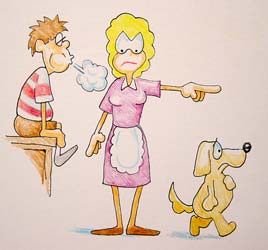
Castlebar Health Newsletter
content supplied by John O'Donnell Pharmacist
Tel: 094 24524 Fax: 094 27884
ASTHMA
Health Index
Back to Castlebar
Asthma:
WHAT CAUSES ASTHMA?
There are three principal factors: an allergy, infection and stress, of which the first is by far the most important. Infection plays a modest part, and fortunately stress is a very minor one.
Allergy is an irrational defence reaction by the body to some outside stimulus: a protective response gone wrong, in fact. The child comes in contact with something to which he is allergic and his air passages start closing down almost as if making a desperate attempt to keep out the foreign material.
If your child has asthma, you can begin by trying to identify the allergen. You may not succeed, but it's worth a try. Pollen, house dust, the dander (shed skin cells) from animals and moulds are all possible causes. And these are causes, which you can do something about by keeping the child away from them. In very sever cases where there is no other solution, it may even be necessary to move to a house with less dust.
In the last few years, it's become apparent that certain foods can provoke allergy and hence asthma attacks. These include milk, eggs, cheese, coffee and food additives such as the yellow dye called tartrazine. Your family doctor or a specialist can advise you about what items of food to exclude from your child's diet to try to find out what's provoking the attacks.
Unfortunately, identifying the allergen is largely a question of trial and error. Skin tests for allergy can be arranged at special centres but they aren't all that reliable. Home trial and error is often just as good. For instances if a girl is always sneezing when she wakes up in her bedroom but fine when she's out in the open air, it's likely that she's allergic to house dust.
top
DrugTherapy:
Modern therapy is very effective, but must be closely supervised by a doctor. He will wish to adjust the treatment regularly, taking into account how severe the child's symptoms are. Another important guideline is provided by the youngster's "Peak Flow Rate" (PFR), which is measured regularly, using a simple device which the child blows into
The drugs which are available include:
Bronchodilators:
These widen the child's airways making it easier for his breath to move in and out.Preventers:
These are drugs which reduce the swelling and mucus in the child's airways.Protectors:
These are longer acting medicines, which must be taken regularly in order to keep the air passages open.Please note that neither the preventers nor the protectors can be used to treat a sudden attack. Attacks must be treated very promptly by bronchodilators or by steroids given orally.
Steroids:
These are very powerful anti-inflammatory agents which can "damp down" the wild allergic reaction of asthma. In a crisis they are often life saving. However, they can have potentially serious side effects (including stunting the child's growth), so most children aren't given them long-term but only when they are really necessary.top
Ten easy ways to control your Asthma:
Whenever you need to buy medicines in a pharmacy always say that you are an asthmatic as some medicines can make your asthma worse rather than better. If you have any questions or require any other information about your asthma or your inhaler please discuss them with your pharmacist or doctor. At O' Donnell's Pharmacy, we are always available for advice, and only too willing to give it.
1. Ask your doctor or pharmacist to check that you are using your inhaler correctly. This will help to ensure that you get the full benefit from each puff of your inhaler.
2. Many people have some difficulty using an aerosol inhaler. Using a Spacer or plastic bubble device with the inhaler can help and will reduce any side-effects from your brown (preventer) inhaler. They need to be washed every two weeks and allowed to drip dry. Spacers should be replaced every six months. Aerochambers, used mostly by young children, should be replaced when the flaps become stiff or "dog-eared". Please check that your child has the correct size Aerochamber (the mask must fit over the nose and mouth).
3. If you have a brown (preventer) inhaler you must use it every morning and night without fail unless otherwise stated by your doctor. It is important to rinse your mouth and throat after using your brown inhaler to prevent dryness or hoarseness.
4. If you feel caught for breath and need to use your blur (reliever) inhaler at the same time as your brown (preventer) inhaler, the BLUE inhaler should be used first. As it starts to work, the reliever inhaler will open the airways and so will allow the spray or powder from the brown inhaler to reach more deeply into your lungs.
5. If exercise (even going for a walk) makes you feel breathless, using your blue inhaler before your exercise will lessen your symptoms.
6. Keeping an Asthma Diary will help you to keep track of your symptoms and with the correct use of your inhaler it will assist you in controlling your condition rather than letting it control you. Ask your doctor or pharmacist about this.
7. It is most important that you see your doctor at least every six months for a check-up, even if you feel well. Bring your Asthma Diary with you each time as this will be useful if you need any changes in your treatment.
8. If you get a cold or your Peak Flow is 80% you may double the dose of your preventer (brown) inhaler and use your reliever (blue) four times daily if necessary. If your symptoms do not improve after 2 or 3 days or if you feel worse, you have to see your doctor as early as you can. If your symptoms do improve it is usually recommended to stay on the double dose of your preventer inhaler for one week.
9. Asthma is an allergy. It may be triggered by being in contact with House Dust (especially in your bedroom), pollen, animal hair and the common cold.
10. FIVE MINUTE RULE
You and your family and friends should recognise a severe asthmatic attack and what to do:
If an asthmatic cannot finish a sentence in one breath
If they feel little or no relief for FIVE minutes after using their reliever inhaler
If they cannot walk a short distance without needing to stop for breath THEN medical help is needed immediately (either your local doctor or the nearest hospital).
Meanwhile the asthmatic (adult) should be given up to ten puffs of their blue (reliever) inhaler. This should be given one puff at a time through their Spacer or plastic bubble device.
top
